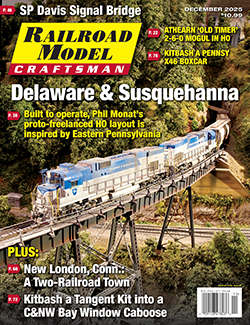 by Brooks A. Bentz/photos as noted
by Brooks A. Bentz/photos as noted
Located on the eastern shore of Connecticut, New London is a town made for model railroading. The small city and its cross-river sister, Groton, have a captivating history, from being attacked by the British during the Revolutionary War, to being the self-billed “Submarine Capital of the World.”
New London was a major port for privateers during the War of 1812 and for whaling later in that busy century, hence its nickname “The Whaling City.” In more current times it is the home to the Electric Boat Division of General Dynamics, builder of nuclear submarines and the U.S. Submarine Base, just up the Thames River.
New London was the southern terminus of the Central Vermont Railway (CV), which had been controlled by Canadian National since 1923. In 1995, it was sold to RailTex and became New England Central Railroad. NECR has been part of Genesee & Wyoming since 2012.

ABOVE: New Haven Alco RS-3 529 is servicing the Central Vermont interchange track at New London station in the early 1960s. The Gold Star Memorial Bridge carrying Interstate 95 and U.S. Route 1 over the Thames River can be seen in the background. —New Haven Railroad Historical & Technical Society Collection
The New York, New Haven & Hartford (NH) “Shore Line” route between New York and Boston served New London, becoming part of Penn Central in 1969, and Conrail in 1976. Amtrak took over the remaining passenger services in 1971, and the state-supported Shore Line East commuter train to New Haven began service in 1990.
A third railroad, the Norwich & Worcester, also called on New London. Opened in 1839, this independent line was leased by the New Haven, and following the bankruptcy of Penn Central was later acquired by short line Providence & Worcester. Today, the P&W also provides freight service on Amtrak’s Northeast Corridor.
New London has many attractive qualities from a rail standpoint that make it model-worthy. The facilities are small and compact, front on the Thames River, with adjacent docks and ferry terminals and a series of diverse and interesting bridges and trestles throughout.

ABOVE: The CV turntable was still in place at New London on March 14, 1982, but the roundhouse (to the photographer’s back) would not last long. —Bruce MacDonald
Built in 1887, Union Station was served by both NH and CV, until CV exited the passenger business on its Southern Division in 1948. The New Haven saw about 10-15 trains per day on its Shore Line route that is now part of Amtrak’s electrified Northeast Corridor between Boston and Washington, D.C. New London was also the originating point for local passenger service to New Haven (The Clamdigger), and at times a New London-Providence or New London-Boston local service, typically operated by Budd rail diesel cars (RDCs) in later years.
Facilities
On the New Haven side, there was a small engine terminal, turntable, company material yard, and a small yard and freight house just across Shaw’s Cove, less than a mile to the west. There was an active interchange of freight with CV over the curving wooden trestle just a stone’s throw east of Union Station, which is still in use today. Central Vermont also had a respectable engine facility with turntable, roundhouse, and service tracks along with a modest freight yard just north of the Gold Star Bridge.
In earlier times, CV operated a steamship from a downtown pier in New York City with direct service to New London. Parcels and less-than-carload freight put on the steamer would be loaded on the express car of the passenger train serving stations along the route north. In effect, they offered next-day delivery to towns along the route in a time well before FedEx and UPS.

ABOVE: Providence & Worcester U23B 2202 and GP38-3 2010 lead Train NR-2 out of the New England Central (ex-CV) interchange and across Winthrop Cove at New London in August 1999. —Jack Hughes photo
Prototype Operations
Let’s take a look at prototype operations and then explore how this might translate to the modeling version. Into the 1960s, New Haven ran a large number of passenger trains on the Shore Line, virtually all of which stopped in New London. While schedules and timing varied over the years, there were between 12 to 14 trains in each direction. New London also originated The Clamdigger local to New Haven and hosted a Providence-New London all-stops local train that later utilized the unique RDC equipment known as The Roger Williams.
The Shore Line was also host to extensive New Haven freight operations. Most trains operated between New York and Boston, but others headed north after crossing the Thames River along the former Norwich & Worcester line. Worcester was a major connection to Boston & Maine and New York Central’s Boston & Albany line. The B&M provided bridge service to northern New England, connecting Maine Central and Bangor & Aroostook. Freight destined to New England and Canada from the Pennsylvania Railroad was floated across New York Harbor from Greenville, N.J., to the NH at Bay Ridge in Brooklyn, or Oak Point in The Bronx, where it was forwarded to New London and interchanged with CV…



